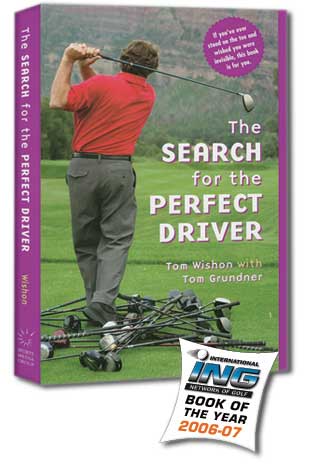
I just got done reading Tom Wishon’s 2006 book ‘The Search For The Perfect Driver.’
For those who don’t know much about Wishon, he’s been a club designer for decades and was the head of club design for GolfSmith and designed clubs for pros like Payne Stewart. Many consider him to be one of the foremost experts on club design and club fitting. I currently use the following Wishon equipment:
Wishon 919THI driver
Wishon 929HS 3-wood
Wishon 775HS hybrid
Wishon 555C 3 & 4-irons
Wishon 555M 5-PW
The book is in a ‘FAQ’ format. I didn’t find too much of a problem with this because there are so many fallacies with regards to driver design and fitting that the point gets across better in this format.
One of the major fallacies that Wishon uncovered was the ‘hot spot’ of the driver as I went over in my previous post. http://3jack.blogspot.com/2012/01/understanding-hot-spot-for-driver.html
A strongpoint of the book is that not only does Wishon uncover the fallacies like the ‘hot spot’ of the driver being near the crown, but he explains why and how this became a myth. It’s always more difficult to believe somebody telling you that the earth is not flat when they don’t explain why that is not true and how that myth came about.
Wishon goes over a variety of other subjects in the book as well such as using graphite versus steel shafts in the driver, optimal length of the driver, shaft length affecting distance, shaft flex myths, bend profiles, shaft kick points, shaft torque, etc.
If there’s an issue I think some readers may have with the book is that Wishon does promote his own equipment from time to time. This may turn off some, but for me he is discussing different facets of the driver that important to fitting and how his equipment designs address those components of the driver. For example, his drivers have virtually no roll design. Meaning, the driver face is as flat vertically as a designer can get a driver face. This eliminates the extra loft added to the driver face towards the crown.
The other possible issue is that this book was published in 2006, before Wishon came out with the 919THI design. Thus, it’s referring to some old equipment designs and features from time to time.
I actually found this helpful with my own *play* because I was no longer trying to tee it up so high in order to his this faux ‘hot spot.’ Instead, if I wanted to hit the ball with a positive attack angle, I was now focused on hitting up but hitting the *center* of the clubface.
I currently play a driver with the following specs:
Wishon 919THI
45.25 inches long
9.0* loft
Aldila RIP Beta Shaft (X-Stiff), 3.2* torque, 66 grams
I now plan on trying this driver combination:
Wishon 919THI
45 inches long
10.0* loft
UST VTS 65 (X-Stiff), 4.0* torque, 68 grams
Perhaps the strongest point of the book came from the fact that over the week I had spoken to many different experts from many different OEM’s that echoed a lot of the statements that Wishon made with driver fitting. The difference was that Wishon wrote about this 6 years ago.
I’ll have to wait and see how the new driver specs fit me. But, Wishon’s knowledge on clubfitting has yet to let me down and he always seems to be ahead of the curve on everything. Still, I am a big believer on how fallacies can ruin a golf swing and thus, I believe that fallacies with regards to equipment can be just as dangerous. I would recommend this book to clubfitters and to those looking to stick with a great driver for their swing for more than 2 years.
3JACK
No comments:
Post a Comment